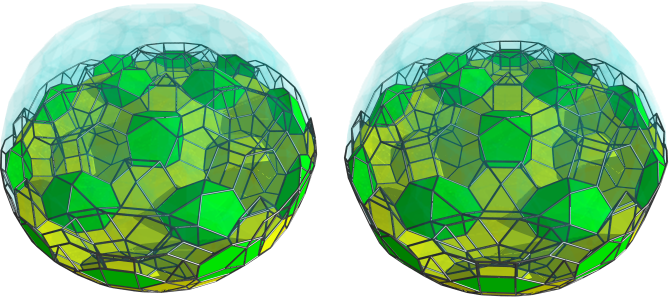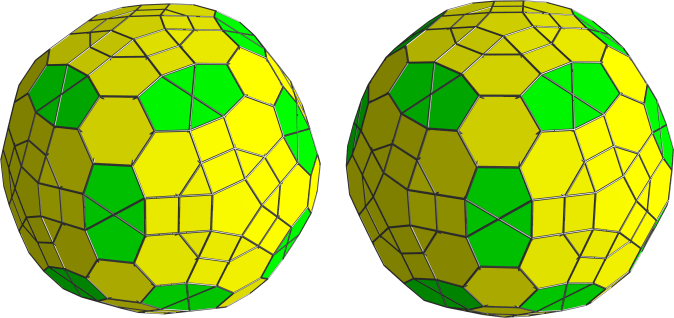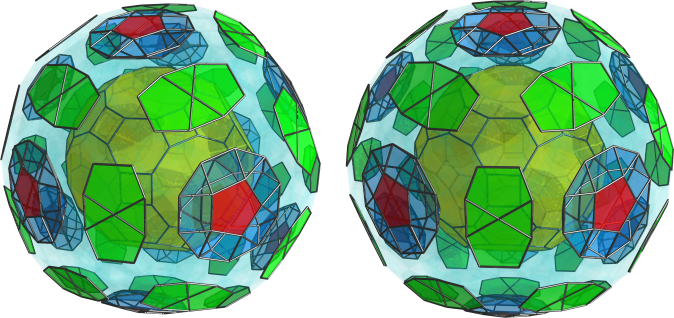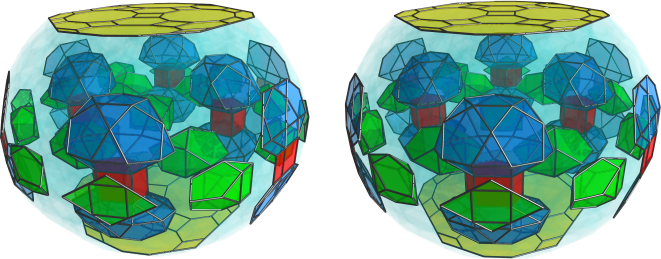D4.6 (EntityTopic, 15)
From Hi.gher. Space
(stub) |
(the cells around the introduced pentagonal prisms are cupolarotundae, not just cupolae!) |
||
| (11 intermediate revisions not shown) | |||
| Line 1: | Line 1: | ||
| - | + | <[#ontology [kind topic] [cats 4D Bilbirothawroid]]> | |
| + | {{STS Shape | ||
| + | | dim=4 | ||
| + | | extra={{STS Polytope | ||
| + | }}}} | ||
| + | D4.6 is a [[bilbirothawroid]] discovered by [[student91]] on February 18, 2014. It is a modification of the [[hydrocantichoron]] o5x3o3x, where 30 [[rhodomesohedra]] are replaced by [[bilunabirotunda]]e (J91), with the resulting non-CRF parts substituted by CRF patches containing 12 rosettes of 5 [[hexagonal prism]]s alternating with 5 [[truncated tetrahedra]] encircling pillars of [[pentagonal prism]]s capped by [[pentagonal orthocupolarotunda]]e. | ||
| - | = | + | Its construction is as follows: delete the vertices from o5x3o3x of edge length 2, whose first coordinate is less than the Golden Ratio φ or is equal to 2, then push the remaining vertices together (i.e., if the first coordinate is ≥φ then subtract φ; if it's ≤-φ then add φ). The vertices whose original first coordinates were φ become coincident. Then new points x5o3A are added with first coordinates ±1, where A=6φ. These modifications of o5x3o3x cause a reduction of its equatorial cells into 30 bilunabirotunda (J91s) in icosahedral symmetry, with the 12 gaps between them filled by circles of alternating hexagonal prisms and truncated tetrahedra surrounding a pentagonal prism with pentagonal orthocupolarotundae above and below it. Twelve of the o5x3o's near the equatorial layer are truncated into pentagonal rotundae, and a number of [[stauromesohedra]] become [[triangular cupola]]e. |
| + | == Projections == | ||
Side-view showing equatorial cells: | Side-view showing equatorial cells: | ||
| Line 10: | Line 16: | ||
<[#embed [hash 4C4DG39H89GXR5QJMJSXA2DHF5]]> | <[#embed [hash 4C4DG39H89GXR5QJMJSXA2DHF5]]> | ||
| + | |||
| + | Top-view showing 12 of the 24 pentagonal orthocupolarotunda cells: | ||
| + | |||
| + | <[#embed [hash AYVCARH0WW9Q82DM98E22S7JPC]]> | ||
| + | |||
| + | Side-view showing pentagonal orthocupolarotunda cells: | ||
| + | |||
| + | <[#embed [hash E43YPCK758EMYZ6YCPTD88JK7W]]> | ||
| + | |||
| + | == Software models == | ||
| + | *[[Stella4D]] [http://hddb.teamikaria.com/dl/K5JJP2HQ9F54T8K231H9YJNWS3.off .off file] | ||
| + | *[[Polyview]] [http://hddb.teamikaria.com/dl/NTZRJMB0Y6MFG677YQ53MD6RQC.def .def file] | ||
Latest revision as of 18:40, 10 March 2014
D4.6 is a bilbirothawroid discovered by student91 on February 18, 2014. It is a modification of the hydrocantichoron o5x3o3x, where 30 rhodomesohedra are replaced by bilunabirotundae (J91), with the resulting non-CRF parts substituted by CRF patches containing 12 rosettes of 5 hexagonal prisms alternating with 5 truncated tetrahedra encircling pillars of pentagonal prisms capped by pentagonal orthocupolarotundae.
Its construction is as follows: delete the vertices from o5x3o3x of edge length 2, whose first coordinate is less than the Golden Ratio φ or is equal to 2, then push the remaining vertices together (i.e., if the first coordinate is ≥φ then subtract φ; if it's ≤-φ then add φ). The vertices whose original first coordinates were φ become coincident. Then new points x5o3A are added with first coordinates ±1, where A=6φ. These modifications of o5x3o3x cause a reduction of its equatorial cells into 30 bilunabirotunda (J91s) in icosahedral symmetry, with the 12 gaps between them filled by circles of alternating hexagonal prisms and truncated tetrahedra surrounding a pentagonal prism with pentagonal orthocupolarotundae above and below it. Twelve of the o5x3o's near the equatorial layer are truncated into pentagonal rotundae, and a number of stauromesohedra become triangular cupolae.
Projections
Side-view showing equatorial cells:
Top-view with highlighted equatorial cells:
Top-view showing 12 of the 24 pentagonal orthocupolarotunda cells:
Side-view showing pentagonal orthocupolarotunda cells:




